Lindsay and I always make sure to have at least half-dozen eggs in the fridge. As an aside, we make sure to buy good eggs from healthy chickens, usually from Knoll Krest, Flying Pigs Farm, or Grazin’ Angus Acres. More about our eggs in a future post. The primary reason that we make sure to keep eggs on hand is that when we have leftover vegetables that are getting long in the tooth, we often like to make a frittata.
A frittata is a baked omelet. That’s all it is. Because there is no folding involved it’s actually a lot easier than a “normal” French omelet. And you can pretty much dump the kitchen sink into it.
Frittata isn’t a recipe so much as it is a universal technique. It’s the swiss army knife of leftover disposal.
If we have bell peppers that are getting wrinkled and rubbery and are no longer salad-worthy, we use them in a frittata. If we sauté leafy greens and don’t eat all of them, they don’t reheat well, so we use them in frittata. In today’s photos, we had been getting tired of eating leftovers of my roasted vegetables.
- Get out a cast iron skillet. If you have more than one cast iron skillet, your choice will depend on how deep the ingredients are that you want to add. In our photos, the roasted vegetables are pretty thick, so we used a smaller pan to get a deeper frittata. If you only have one cast iron skillet, it’ll still be fine. If you don’t have a cast iron skillet, get one
.
- Start by mixing the eggs as if you were making an omelet or scrambled eggs. We use 4 -6 eggs depending on the amount of “leftovers”. In these pictures we used 5 eggs. Crack the eggs into a bowl, add a little milk (optional), and whisk.
- Put the “leftovers” in the cast iron skillet and space them evenly. Pour in the egg mixture and heat the skillet over medium to medium-high heat.
- Once you have the heat going, add some (Kosher) salt and freshly ground pepper. If you want to mix in cheese, now is the time to do so.
- At this point, you should turn on your broiler. Frittata works best of you have a gas oven with a separate broiler at the bottom, because those literally shoot fire balls straight over the pan. However, it works fine if you simply have an oven that has a “broiler” setting for the main compartment.
- Leave the pan alone on the stove top for a few minutes. The next step comes when the edges of the eggs start to brown against the side of the skillet:
- If you want to add grated cheese on top of the frittata (as opposed to mixed in), add it now. Remove the skillet from the stove top and put the entire skillet into the broiler / oven. This step is why it is important to use a cast iron skillet. Do not put a non-stick pan in the oven. Set a timer for 3 minutes. Check in on the frittata every minute after that until it is nicely browned but not burned:
- Get out a trivet
, because you don’t want to scorch your counter. As a bone-headed man, I have damaged many things. Also remember to use a thick oven mitt or pot holder, because the handle of the pan will be hot. Among the many things I have burned is myself.
- Let the skillet cool (on the trivet) for a few minutes. This will also give the frittata time to set. Once it is no longer steaming, cut into it with a spatula. If you cut cleanly and straight through, your first slice should come out of the pan quite cleanly.
- Frittata can make a great breakfast, lunch, or dinner. Stocked full of leftover vegetables, it’s a healthy option.
If you have leftover frittata (meta-leftovers?), let the pan cool completely, and cut it into individual slices before refrigerating. It reheats well in the microwave.
In order to make our lives easier, Lindsay and I tend to cook in volume so that a meal will stretch a few days. The downside is that repetition eventually gets boring. Frittata makes the old new again. Enjoy!

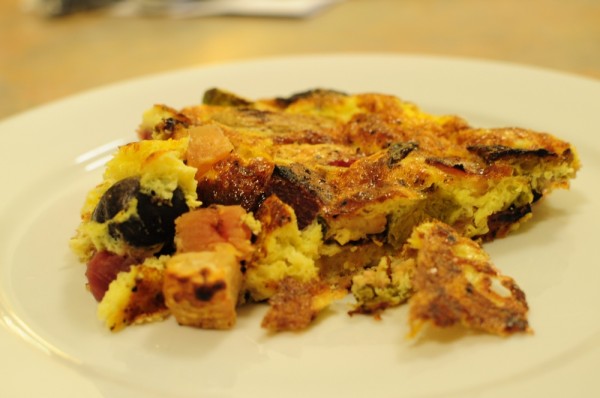
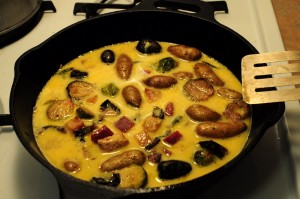

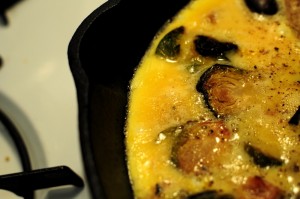
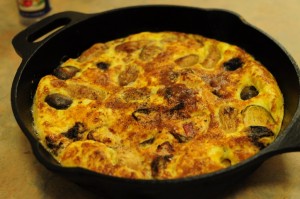
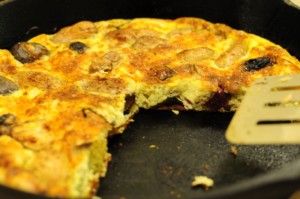

[...] our party, and otherwise we stuck to simple meals that we’ve already posted about, such as frittata and roasted [...]
[...] unsmoked bacon and the joy is in the decadence. Mmmmmmm…I’m really glad Erik is making frittata for dinner right now, because my tummy is growling. Can you hear [...]
[...] posted before about how a frittata is our go-to dish for getting vegetables out of the refrigerator. In the late summer we have a second play out of that same playbook to use up vegetables that, [...]